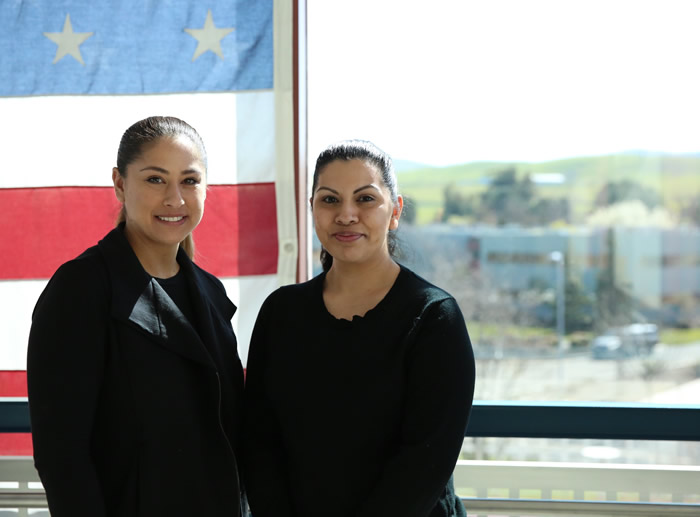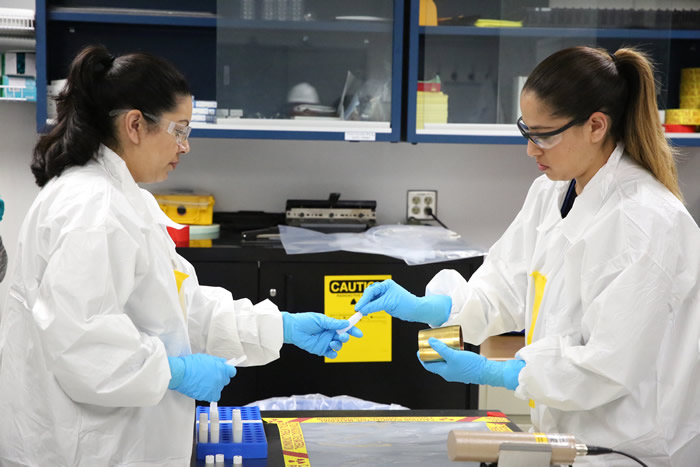NIF & PS People - 2017
April
Rad to the Bone: From Custodians to Radiation Technicians
It is 6:30 a.m. when Myrna Gutierrez and Judy Zarco suit up inside the National Ignition Facility to begin their thirteen-hour shift. In their role as radiation control technicians (RCTs), they will help maintain the safety of a 10-story building the size of three football fields housing the world’s largest, most energetic laser.
It’s far from an average workplace, and the stakes are high when teams of researchers from around the world are counting on you for support. Despite little room for error, Gutierrez and Zarco will tell you this is where they want to be, and their demanding journey from cleanroom custodians to RCTs demonstrates their dedication to advancing their careers and contributing to LLNL’s mission.
 Radiation control technicians Myrna Gutierrez (left) and Judy Zarco at the National Ignition Facility. Credit: Kate Hunts
Radiation control technicians Myrna Gutierrez (left) and Judy Zarco at the National Ignition Facility. Credit: Kate Hunts In 2010 NIF was transitioning to a radiological facility, requiring new radiological waste disposal and maintenance crews. RCTs are usually hired from outside the Lab—either from the military or from other nuclear facilities—but the large need opened a door for anyone who wanted to volunteer to train for the specialty. Gutierrez and Zarco were working as cleanroom custodians and saw this as a unique opportunity to learn more about the position. They asked their supervisor what they could do to move up.
“I went forward with it because they had the right attitude,” said NIF Radiation Safety Officer Richard Beale. “This was an opportunity to learn things that they wouldn’t be able to anywhere else,” he said. “Their great work ethic and positive attitude put them at the top of our trainee list.”
Gutierrez and Zarco began a two-year full-time radiation safety program at Las Positas Community College, taking courses ranging from hazardous material to physics, biology, and chemistry. They also attended RCT training at NIF, all while working 13-hour shifts. On top of the demanding schedule, Zarco was pregnant with her now 21-month-old daughter Adelina.
“I want my daughter to see that it’s important for women, even after having children, to stay focused and work on their education,” Zarco said. “Juggling work and school was challenging, but it was something that I wanted to accomplish.”
For her part, Gutierrez “took it one day at a time. I had to say no to a lot of things," she said. "Everyone at the Lab including management was encouraging. Having Judy there along the way was very helpful too, because we motivated each other.”
Gutierrez had others in her corner at the Lab: both her mother Maria and her father Camerino Gutierrez are cleanroom custodians. “It’s really cool to work alongside him,” Gutierrez said. “He’s proud of me. He’s seen me go through this firsthand.”
The world’s highest-energy laser became a classroom where they could learn on the job. Senior RCTs helped by answering questions and invited them to be assistants in the field. Coupling real-world experience with the classroom helped them understand concepts while building relationships with the existing team.The two technicians are the only women on the crew, but integration was easy because everyone had seen how hard they worked to master the trade. “They are respected for their skills and their knowledge,” Beale said. “Everyone knew they could count on them and were part of the team. They are better junior RCTs than most I’ve seen.”
 Zarco (left) and Gutierrez at work in a NIF radiation cleanroom. Credit: Kate Hunts
Zarco (left) and Gutierrez at work in a NIF radiation cleanroom. Credit: Kate Hunts LLNL has a legacy of encouraging continuing education and tries its best to accommodate employees’ schedules if a class time interferes. The Lab rewards eagerness to learn, and the goodwill of coworkers is not in short supply. “There’s always great room for career growth for anyone with that attitude because they’re willing to learn and work hard,” said Beale. “It makes coming to work fun. It’s natural to want to help people like that improve themselves.”
“The Lab encourages employees to further their education,” added Zarco. “They offer a great support system. It was important to have the Lab’s support and have someone like Richard encouraging and advocating for us along the way. It shows other people that they can do it too.”
Gutierrez has headed back to the classroom, seeking a bachelor of science degree in environmental health and safety from Oakland University, and is expected to graduate in April of next year. She recently received a $1,400 scholarship from the Lawrence Livermore Women’s Association and hopes to pursue a master’s degree. “After going through this journey, I have a lot of confidence and motivation,” she said. “I can apply this to so many things outside of school.”
Zarco is completing her associate’s degree in occupational safety and health. She plans on completing her bachelor’s degree next. “I’m proud of myself for being able to do this,” she said, “and there’s more that I’m hoping to accomplish in the future.”
“RCT is just a stepping stone for them,” noted Beale. “Ten years down the line when one of them is my boss, I’ll be fine with it. I don’t think there’s a limit to how well they can do at the Lab.”



